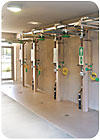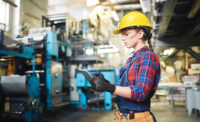
In a free-market economy, the marketplace decides specifically what it wants and moves in that direction. When buggy whips were no longer needed, they went away… probably replaced by accelerator pedals. The market dictates and manufacturers respond.
Over the past several years, a migration of product preference has slowly taken place in the emergency equipment market, spurred by some of the “Big Guys” in industrial categories like chemical and power production, petroleum refining and microprocessor fabrication. But the visibility of these advancements has often been hidden from the view of the industrial community at large.
Under the radar
Much to the credit of the large companies, they continue to be concerned for the safety and security of their employees. They are constantly pushing the envelope seeking unique ways to do a more effective job of minimizing risk and preparing for outstanding response in the event of an incident. However, there is usually a reluctance on the part of the specifying company to “go public” with the advancement using their name. Unfortunately, in this day and age, publicizing an advancement also means publicly acknowledging that there may be a “danger” present in your operation to begin with. And that is a position most companies would understandably rather avoid.
Most of the advancements, however, are available for use by other companies. Many of them become standard product offerings or are eventually offered as new products. However, few receive the marketing fanfare needed to make them stand out appropriately, due to low startup sales volumes. The moral of this story is, “If you don’t see what you need – ask for it!”
As a general statement, the “Big Guys” are tapping the engineering expertise of the equipment manufacturers with whom they collaborate. Several examples of the results of these collaborations are:
The moral of this story is that one should ask for what you need, whether you see it or not. Advancements in all areas of emergency equipment design are being made almost daily, so what you need may already be available. Or you just might be the specifier that collaborates on tomorrow’s advancement.
Most of the advancements, however, are available for use by other companies. Many of them become standard product offerings or are eventually offered as new products. However, few receive the marketing fanfare needed to make them stand out appropriately, due to low startup sales volumes. The moral of this story is, “If you don’t see what you need – ask for it!”
As a general statement, the “Big Guys” are tapping the engineering expertise of the equipment manufacturers with whom they collaborate. Several examples of the results of these collaborations are:
- Enclosed Emergency Environments (E3) — packaged, plug-and-play self-contained emergency equipment systems custom-tailored to each specific application.
Many large companies realize that with the advent of tempered water and reverse tempering, often in addition to re-circulation and booster pump requirements, designing an integrated emergency response system has become an exact science. This is especially true in applications where multiple showers and eyewashes may be called into service simultaneously (see photo). Specifiers are finding that relying on the expertise of manufacturers to package balanced and matched components saves time and money, while guaranteeing the best possible outcome. The beauty is that once the engineering for a particular application is completed, subsequent specifiers can reap the benefit of the knowledge gained and the groundwork already laid.
- The availability of skid-mounted, balanced and matched emergency systems has also dramatically aided remote and “special needs” locations. Products, like air charged systems, provide full ANSI compliance in the toughest of locations. And fully self-contained portable shower and eyewash equipment enhances on-the-go safety. There is even a 12-volt (vehicle powered) heated eyewash available as a result of a customer/manufacturer design collaboration.
- Wireless technology, applied to remote monitoring of emergency equipment, is another example of a collaborative initial product design now available for more widespread use. Traditional hard-wired installation of remote monitoring componentry can cost up to $50 per foot and still be quite vulnerable to damage. By comparison, wireless monitoring – using an RF radio to transmit shower or eyewash activation — is much less expensive and labor intensive to install and maintain, while also being less susceptible to physical damage. And most quality systems are designed to provide continuous self-diagnosis and system integrity monitoring. Again, the initial design collaboration was completed without fanfare and a superior product is now available for general use.
The moral of this story is that one should ask for what you need, whether you see it or not. Advancements in all areas of emergency equipment design are being made almost daily, so what you need may already be available. Or you just might be the specifier that collaborates on tomorrow’s advancement.
